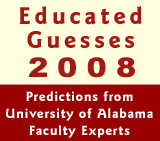 Violent crime will continue to increase in 2008 after a slowing economy and cuts to community policing programs, says Dr. David Forde, professor of criminal justice at The University of Alabama.
Violent crime will continue to increase in 2008 after a slowing economy and cuts to community policing programs, says Dr. David Forde, professor of criminal justice at The University of Alabama.
What’s more, 2008 could be a watershed year for communities trying to regulate handgun ownership as the U.S. Supreme Court reviews a Second Amendment challenge to a District of Columbia ban on handguns.
According to the FBI, violent crime, which had decreased in 2003 and 2004, began to rise in 2005 and 2006, with an estimated 1,417,745 violent crimes nationwide or 473.5 violent crimes per 100,000 inhabitants (www.fbi.gov/ucr/cius2006/offenses/violent_crime/index.html).
Among the causes Forde cites are the instability in the U.S. economy and the lack of funding for community policing – cops on a beat attacking petty crimes – which create an atmosphere conducive to more violent offenses.
“In the middle of an economic downturn, resources get trimmed,” Forde says. “COPS on the beat funds for new officers were significantly cut four years ago, and additional monies were diverted two years ago to anti-methamphetamine efforts, so it’s no surprise that crime is back up.”
Also in 2008, the nation’s cities and towns will face the consequences of an upcoming Supreme Court case – District of Columbia v. Heller (07-290). The case challenges a D.C. ordinance banning private ownership of handguns based on the Second Amendment. The court will decide if such a ban violates the Second Amendment, which states, “A well regulated Militia, being necessary to the security of a free State, the right of the people to keep and bear Arms, shall not be infringed.”
Handguns figure significantly in violent crime, Forde says. Therefore, any opinion rendered by the Supreme Court will affect communities’ efforts to curb gun violence.
“The ease of availability of handguns without a doubt is related to the high homicide rate in the United States,” Forde said.
Source
Dr. David Forde, 205/348-7781, dforde@ua.edu